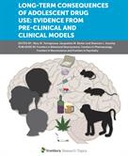Explore

Long-Term Consequences of Adolescent Drug Use: Evidence from Pre-Clinical and Clinical Models
0 Ungluers have
Faved this Work
Login to Fave
The purpose of this collection is to provide a forum to integrate pre-clinical and clinical investigations regarding the long-term consequences of adolescent exposure to drugs of abuse. Adolescence is characterized by numerous behavioral and biological changes, including substantial neurodevelopment. Behaviorally, adolescents are more likely to engage in risky activities and make impulsive decisions. As such, the majority of substance use begins in adolescence, and an earlier age of onset of use (<15 yr) is strongly associated with the risk for developing a substance use disorder later in life. Furthermore, adolescent drug use may negatively impact ongoing neurological development, which could lead to long-term cognitive and emotional deficits. A large number of clinical studies have investigated both the acute and long-term effects of adolescent drug use on functional outcomes. However, the clinical literature contains many conflicting findings, and is often hampered by the inability to know if functional differences existed prior to drug use. Moreover, in human populations it is often very difficult to control for the numerous types of drugs, doses, and combinations used, not to mention the many other environmental factors that may influence adult behavior. Therefore, an increase in the number of carefully controlled studies using relevant animal models has the potential to clarify which adolescent experiences, particularly what drugs used when, have long-term negative consequences. Despite the advantages of animal model systems in clarifying these issues, the majority of pre-clinical addiction research over the past 50+ years has been conducted in adult animals. Moreover, few addiction-related studies have investigated the long-term neurocognitive consequences of drug exposure at any age. In the past 10 years of so, however, the field of adolescent drug abuse research has burgeoned. To date, the majority of this research has focused on adolescent alcohol exposure using a variety of animal models. The results have given the field important insight into why adolescents are more likely to drink alcohol to excess relative to adults, and the danger of adolescent alcohol use (e.g., in leading to a persistence of excessive drinking in adulthood). More recently, research regarding the effects of adolescent exposure to other drugs of abuse, including nicotine, cocaine, and cannabinoids has expanded. Therefore, we are at unique point in time, when emerging results from carefully controlled pre-clinical studies can inform the sometimes confusing clinical literature. In addition, we expect an influx of prospective clinical studies in response to a cross-institute initiative at NIH, known as the ABCD grant. Several institutes are enrolling children prior to adolescence (and the initiation of drug use), in order to control for pre-existing neurobiological and neurobehavioral differences and to monitor the age of initiation and amount of drug used more carefully than is possible using retrospective designs.
This book is included in DOAB.
Why read this book? Have your say.
You must be logged in to comment.
Rights Information
Are you the author or publisher of this work? If so, you can claim it as yours by registering as an Unglue.it rights holder.Downloads
This work has been downloaded 481 times via unglue.it ebook links.
- 167 - mobi (CC BY) at Unglue.it.
- 182 - epub (CC BY) at Unglue.it.
- 132 - pdf (CC BY) at Unglue.it.
Keywords
- alcohol
- cannabinoid
- cocaine
- Juvenile
- ketamine
- medicine
- Methamphetamine
- Nicotine
- Prefrontal Cortex
- Sex differences
- Stress
Links
DOI: 10.3389/978-2-88945-530-0Editions

